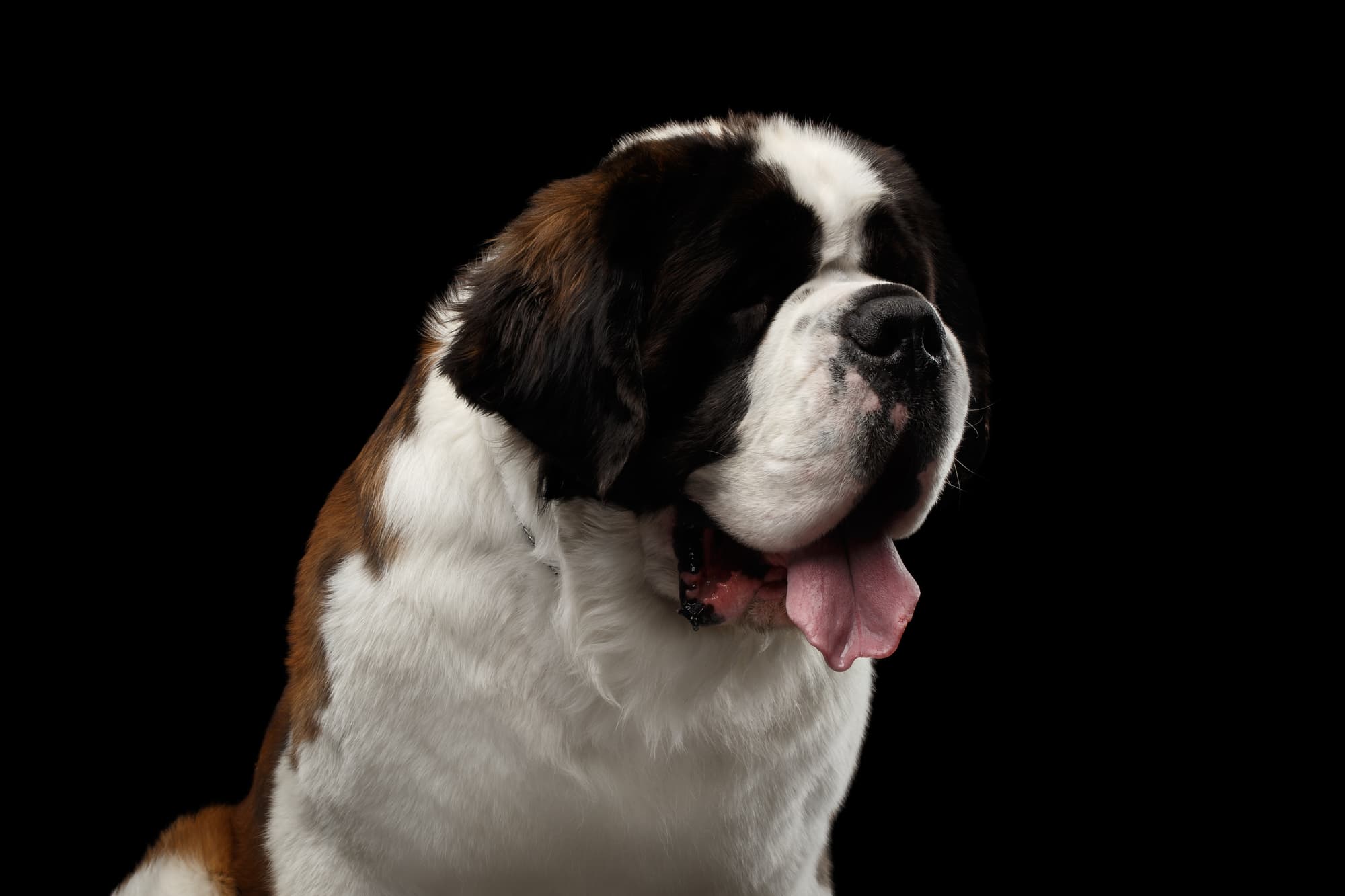Probably history’s most courageous Saint Bernards is Barry, who worked at the Hospice of St. Bernard, a refuge for pilgrims crossing the treacherous passes of the Swiss Alps on their way to Rome. Between 1800 and 1814, Barry saved 40 human lives. In memory of this heroic rescue dog, the Barry Foundation Museum was established in Martigny. Barry’s heroism has provided a model for countless fictional Saint Bernards through the years and played a major role in establishing the breed’s reputation.















Saint Bernard
Although the typical Saint Bernard’s size can be intimidating, even first-time dog owners can quickly strike up a relationship with the famed Alpine rescuer. If you are looking for a companion dog with high intelligence, this could be the breed of choice.
Country of Origin
Switzerland
Breed Group
Working Group
Height
Male 26-30 In
Female 26-28 In
Weight
Male 120-140 Ib
Female 120-130 Ib
Life Span
8-10 years
In a Nutshell
Large and unusually muscular, Saint Bernards are a working dog breed with roots in the Swiss and Italian Western Alps. Despite their massive size, the breed easily navigates rugged terrain and are renowned for their ability to rescue lost travelers.
Despite his size, the Saint Bernard is a quiet indoor dog who makes a wonderful family friend. Although he’s calm indoors, it’s nice if he has easy access to a yard where he can have a little room to spread out. He can live in small quarters, however, as long as he gets a good daily walk. More important than the size of your home is your tolerance for mess. Saints aren’t the best choice for a fastidious housekeeper. They drool and shed, and they track in mud and dirt. With this breed, saintliness is not necessarily next to cleanliness.
Life With a Saint Bernard
Looks & Personality

The Saints are extraordinarily muscular, watchful, and patient dogs making them one of the most beloved and famous breeds globally. A male Saint Bernard stands about 30 inches above the ground at the shoulder and has a distinctive, broad face. The female is more delicately built and slightly smaller than the male. A Saint Bernard features a wrinkled brow and short muzzle with dark eyes. The combination gives them a friendly, intelligent look.
They’re affectionate with just about everyone they meet, and people who don’t mind a bit of drool will find them to be loving companions. True to their heritage as hospice dogs, Saints are friendly and welcoming. They have a steady, benevolent temperament and are kind and careful with children. They love attention but aren’t as demanding of it as some breeds.
Just keep in mind that the breed’s immense size can make for unintentionally rough play. A swipe of the Saint’s tail could be enough to knock a small child down, so be careful. Though they rarely show aggression, the breed can grow protective over its people.
Saint Bernard does not need a lot of exercise. He’s not a jogging companion and will wilt in hot climates. Saints suffer from heat exhaustion quite easily and need access to shade and plenty of fresh, cool water during hot weather. On the other hand, you’ll never find a happier Saint Bernard than one who’s enjoying a good romp in the snow.
St. Bernard is a much-loved breed today. He’s versatile, good-natured, and a fine choice for the person or family who would like a large but gentle dog with moderate exercise needs.
Common Health Problems


The Saint's giant size condemns him to a shorter than average canine life span. Due to his physique, Saints have a higher risk of developing conditions such as hip dysplasia, bloat, and heart disease.
A tip from a vet
A tip from a trainer
Did You Know

An adult Saint Bernard can weigh up to 180 pounds, but the puppies can be as tiny as 1.5 pounds.

Saint Bernards generally take longer to mature mentally. This leaves you with a very big puppy for several years.

The breed is a poor choice for especially neat dog owners – they shed heavily twice a year and drool a lot.
In The News
The History Behind the Breed
The massive Saint Bernard originated in Switzerland with other breeds such as Bernese Mountain dog and Greater Swiss Mountain Dog. Different mythical and legendary stories surround their roots. Traditionally, it is believed that the Saints were bred in a monastery hospice high in the Swiss Alps as early as the 11th century. Here, they were used as watchdogs.
Later, the life-saving capabilities of the breed became obvious when they helped stranded travelers escape the unforgiving terrain of the Alps. From around 1703, when the first record of monastery-dwelling Saint Bernards appeared, the dogs are credited with rescuing more than 2000 people.
The English referred to them as Sacred Dogs and imported many of them into England in an effort to reinvigorate their own Mastiff breed. In Germany, the name Alpendog was suggested for the breed in the 1820s. In 1833, a man by the name of Daniel Wilson suggested that the breed be referred to as the Saint Bernard Dog, and that’s eventually what they became when the Swiss Kennel Club recognized the breed in 1880.
When the breed began to be known in other countries, the Saint Bernard’s type started to change. Saint Bernards in other countries became thinner and taller, the by-product of crossbreeding. In 1887, the International Congress of Zurich drew up the first breed standard and all countries, except England, accepted it.
Today, the breed is a beloved family pet due in no small part to famous pups like Beethoven, the fictional Saint Bernard who starred in a series of children’s films in the 1990s.
Famous Saint Bernard Owners
Get a free quote on pet insurance for
your Saint Bernard
today!














